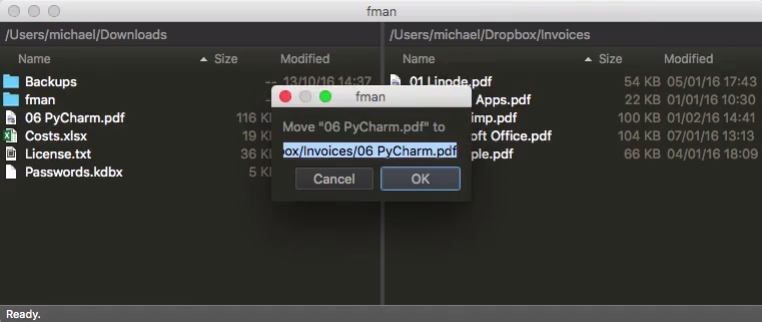fman is a keyboard-powered file manager for desktops

Most Windows file managers sell themselves on working just like Explorer, but adding more features and functionality: more file previews, smarter searching, extra tools, whatever it might be.
Fman’s shareware dual-pane file manager ignores all of that. It’s smaller, has far less functionality than Explorer, is almost entirely powered by the keyboard rather than the mouse, and ignores most Windows conventions. So is there any reason why you might want to install it?
The streamlined interface is a plus. There’s no ribbon, no toolbars, no complicated dialog boxes or "click this"/ "click that" cascading menus to navigate. You just get a couple of panes to view your file system, and some hotkeys to manipulate the contents.
Although the keyboard approach means you’ll have no idea what to do, initially, a single hotkey is enough to get you started. Pressing Ctrl+Shift+P displays the commands palette, a list of the various commands fman supports and their hotkeys.
Options include Copy (F5), Move (F6), Open (Enter), Delete (Del), Rename (Shift+F6), Create folder (F7), Copy to clipboard (Ctrl+C), Copy paths to clipboard (F11), Open terminal (cmd.exe in Windows) at current folder (F9), Open native file manager (F10), and more.
One major advantage of fman is that it’s extensible via plugins. There are only a few of these right now, but they cover a wide range of functionality, from simplifying fman usage (allowing navigation with the arrow keys) to adding extra file management tools (duplicating the current folder on demand), search improvements (selecting files via regex) and even sharing files online (uploading a file to transfer.sh and getting a shareable URL).
Fman is available for Windows, Linux and Mac, too, so once you understand how it works you can manage your files in the same way on all your platforms.
The major down side for us is the near total absence of mouse support. You can double-click a file or drag and drop with the mouse, but there’s no multiselect, no right-click, and even the breadcrumb-like path isn’t clickable. If it’s showing C:\Users\MyName\Folder\More, for instance, you can select the MyName folder with the mouse, but double-clicking won’t switch to it.
The other issue is the price. The shareware download arrives with a nag screen, and if you want to use it regularly you must purchase a license. Prices start at around $15, but even that only gets one year of updates. After that, you’ll pay a subscription of around $13 a year.
Is fman worth your time? If you like the keyboard-oriented approach, we say try it and find out. The download doesn’t expire and it’s interesting to see a file manager which goes its own way.
Fman is available for Windows (7+, probably), Linux and Mac.
